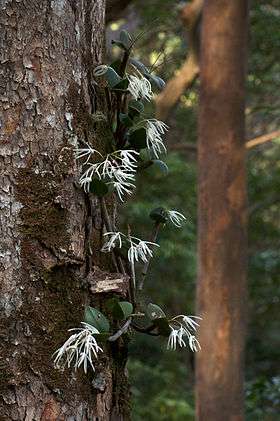Dendrobium aemulum
| Ironbark Orchid | |
|---|---|
 | |
| Dendrobium on a tree in Lamington National Park, Australia | |
| Scientific classification | |
| Kingdom: | Plantae |
| (unranked): | Angiosperms |
| (unranked): | Monocots |
| Order: | Asparagales |
| Family: | Orchidaceae |
| Subfamily: | Epidendroideae |
| Tribe: | Dendrobieae |
| Subtribe: | Dendrobiinae |
| Genus: | Dendrobium |
| Species: | D. aemulum |
| Binomial name | |
| Dendrobium aemulum R.Br. | |
| Synonyms[1] | |
| |
Dendrobium aemulum, known as the Ironbark Orchid or White Feather Orchid is a small orchid found in eastern Australia and in New Caledonia.[1] The habitat is in coastal districts; on rocks, rainforest trees and Ironbark eucalyptus trees. Flowers are attractive and of appeal to orchid growers. These orchids give a pleasant scent. The scent is apparently an attractant to moths who assist in pollination.[2]
The species first appeared in scientific literature in Prodromus Florae Novae Hollandiae in 1810, authored by Robert Brown.
Varieties
Two varieties are recognized:[1]
- Dendrobium aemulum var. aemulum - New South Wales, Queensland, New Caledonia
- Dendrobium aemulum var. callitrophilum (B.Gray & D.L.Jones) Dockrill - Queensland
References
External links
- IOSPE orchid photos, Dendrobium aemulum R. Brown 1810, Photo © Lourens Grobler.
- Australian Native Orchid Society Queensland, KABI Group, Dendrobium aemulum
- Plantnet, New South Wales Flora Online, Dendrobium aemulum
- Orchids of the D'Aguilar Range (South-East Queensland), Dendrobium aemulum (Brush Box Orchid)
- Toowoomba Plants, natives of the region suitable for gardens, Thursday July 31, 2008: Ironbark Orchid, Dendrobium aemulum (Tropilis aemula)
| Wikimedia Commons has media related to Dendrobium aemulum. |
This article is issued from
Wikipedia.
The text is licensed under Creative Commons - Attribution - Sharealike.
Additional terms may apply for the media files.